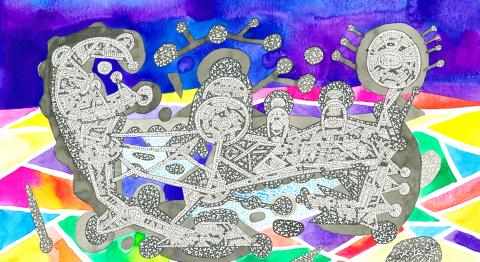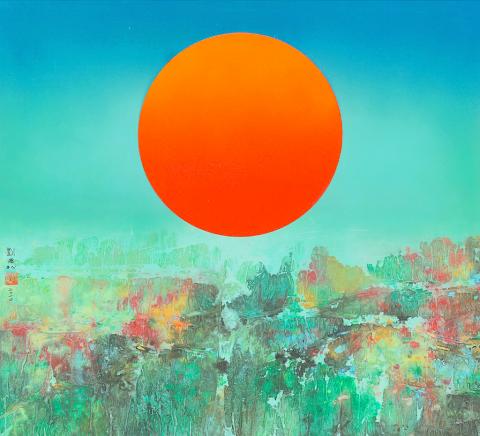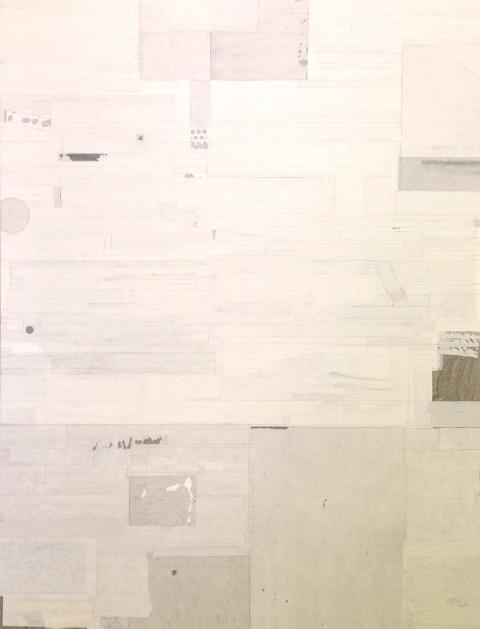Taipei’s Chongqing S Rd (重慶南路) is still called Bookstore Street (書店街), but the fortunes of its stores have waned considerably in the age of online vendors and digital publishers. Think X Chongqing S Rd (思想,重慶南路) looks back at the years between 1950 and 1980, when the street was a powerhouse of Chinese-language publishing. Using archival footage, rare books, replicas of bookshops and other interactive installations, this exhibition tells the story of a unique business ecosystem in its heyday. For more information, visit thinkread.asdc.tw
■ Songshan Cultural and Creative Park (松山文創園區), 133, Guangfu S Rd, Taipei City (台北市光復南路133號), tel: (02) 8170-5125 ext. 6625, open daily from 9am to 5pm. Free admission
■ Until Oct. 26

Photo courtesy of VT Artsalon
As part of a new series titled Pop-up Bluerider, contemporary artist Nick Chou (周立) and fashion designer Isabelle Wen (溫慶珠) offer a crossover exhibition at Bluerider Art for one weekend only. Photography, installation, fashion and other media themed on the sea will be on view tomorrow and Sunday.
■ Bluerider Art, 9F, 25-1, Renai Rd Sec 4, Taipei City (北市仁愛路四段25-1號9樓), tel: (02) 2752-2238, open during this exhibition from 11am to 7pm
■ Until Sunday

Photo courtesy of National Museum of History
The National Museum of History (國立歷史博物館) today opens a large-scale retrospective on modernist Liu Kuo-sung (劉國松). It exhibits over 100 paintings, many borrowed from collections in Singapore, Malaysia and Indonesia, to map the career of an artist widely regarded as the father of modern Chinese ink painting. Born in China’s Anhui Province, Liu moved to Taiwan in 1949, studied fine art at National Taiwan Normal University and went on to found the Fifth Moon Painting Society (五月畫會). Now 82, Liu is internationally acclaimed for an oeuvre that fuses the monumentality of Chinese ink landscapes with western abstraction.
■ National Museum of History, 49 Nanhai Rd, Taipei City (台北市南海路49號), tel: (02) 2361-0270. Open Tuesdays to Sundays from 10am to 6pm. General admission: NT$30
■ Opens today. Until Nov. 23

Photo courtesy of Soka Art Taipei
Since 1983, Chinese artist Liang Quan (梁銓) has been developing works that embody chan (禪), a Buddhist school of thought that values the state of non-being or emptiness. His latest practice is dipping strips of paper in watered-down ink or tea and piecing them together, forming an expanse so pale it seems almost empty. Solo exhibition Joy of Tea (淡茶) displays 17 pieces, half of which were completed this year.
■ Soka Art Center (索卡藝術中心), 2F, 57, Dunhua S Rd Sec 1, Taipei (台北市敦化南路一段57號2樓), tel: (02) 2570-0390. Open Tuesdays to Sundays from 11am to 9pm
■ Until Oct. 26
At solo show Balcony City Civilization Quotation (陽台文明城市語錄), Lin Shu-Kai (林書楷) makes maps of imaginary places that are based on Greater Tainan. He draws aerial views of cities teeming with temples, networked alleys and flowering fields — surreal scenes inspired by memories of home.
■ VT Artsalon (非常廟藝文空間), B1, 17, Ln 56, Xinsheng Rd Sec 3, Taipei City (台北市新生北路三段56巷17號B1), tel: (02) 2597-2525, open Tuesdays through Fridays from 11:30am to 7pm, Saturdays from 1:30pm to 9pm, closed Sundays and Mondays
■ Until Nov. 1
Responspace (空間回應) is a mini-exhibit of interactive art in Taipei Main Station’s K Underground Mall, presented by the Museum of Contemporary Art, Taipei. Pieces include Mirrorwall (渦影), a misbehaving mirror, and Inflatable Cloud (氣墊雲), a sensor-fitted installation of plastic bags that inflate in response to movement. Produced by a team of architects, digital engineers and designers, the projects invite passersby to connect with their surroundings and to become performers.
■ Eslite Taipei Main Station store at K12 West Arts Plaza, B1, 47, Zhongxiao W Rd, Taipei City (台北市忠孝西路一段47號B1), tel: (02) 2552- 3721. Free admission
■ Until Nov. 9

In the March 9 edition of the Taipei Times a piece by Ninon Godefroy ran with the headine “The quiet, gentle rhythm of Taiwan.” It started with the line “Taiwan is a small, humble place. There is no Eiffel Tower, no pyramids — no singular attraction that draws the world’s attention.” I laughed out loud at that. This was out of no disrespect for the author or the piece, which made some interesting analogies and good points about how both Din Tai Fung’s and Taiwan Semiconductor Manufacturing Co’s (TSMC, 台積電) meticulous attention to detail and quality are not quite up to

Chinese Nationalist Party (KMT) Chairman Eric Chu (朱立倫) hatched a bold plan to charge forward and seize the initiative when he held a protest in front of the Taipei City Prosecutors’ Office. Though risky, because illegal, its success would help tackle at least six problems facing both himself and the KMT. What he did not see coming was Taipei Mayor Chiang Wan-an (將萬安) tripping him up out of the gate. In spite of Chu being the most consequential and successful KMT chairman since the early 2010s — arguably saving the party from financial ruin and restoring its electoral viability —

It is one of the more remarkable facts of Taiwan history that it was never occupied or claimed by any of the numerous kingdoms of southern China — Han or otherwise — that lay just across the water from it. None of their brilliant ministers ever discovered that Taiwan was a “core interest” of the state whose annexation was “inevitable.” As Paul Kua notes in an excellent monograph laying out how the Portuguese gave Taiwan the name “Formosa,” the first Europeans to express an interest in occupying Taiwan were the Spanish. Tonio Andrade in his seminal work, How Taiwan Became Chinese,

Toward the outside edge of Taichung City, in Wufeng District (霧峰去), sits a sprawling collection of single-story buildings with tiled roofs belonging to the Wufeng Lin (霧峰林家) family, who rose to prominence through success in military, commercial, and artistic endeavors in the 19th century. Most of these buildings have brick walls and tiled roofs in the traditional reddish-brown color, but in the middle is one incongruous property with bright white walls and a black tiled roof: Yipu Garden (頤圃). Purists may scoff at the Japanese-style exterior and its radical departure from the Fujianese architectural style of the surrounding buildings. However, the property